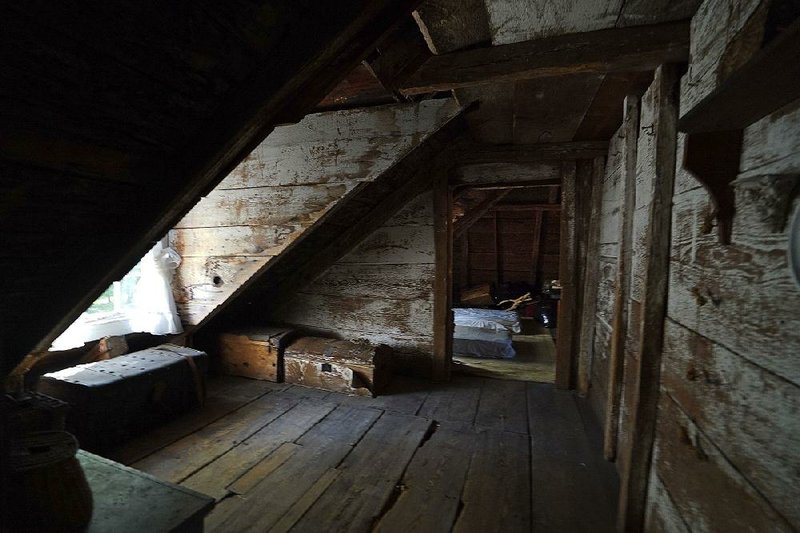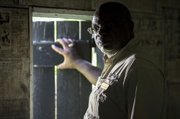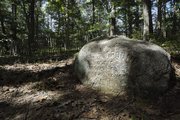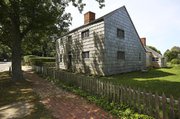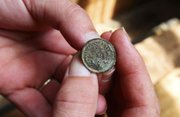Joseph McGill first unrolled bedding in a former slave cabin in 1999. He was participating in a documentary about Civil War re-enactors and the controversy over the Confederate battle flag, and the producers asked McGill -- a black museum professional from South Carolina who dresses in the Union blue -- if he could add some spice to a scene being filmed at a plantation near Charleston.
"The floor was very hard, and the bugs were terrible," McGill, 54, says. "I woke up at about 3 a.m. to the sound of dogs barking in the distance. I'm not sure 'spooky' is the word, but the thought did run through my head of all those who had tried to escape." The experience stuck with him, and in 2010 he formally began the Slave Dwelling Project, with the goal of filling what he calls "a void in preservation" at Southern plantations and beyond.
TOURIST INFO
Sylvester Manor: sylvestermanor.org
Joseph Lloyd Manor: splia.org/lloyd-man…
Southampton African-American Museum: southamptonafricana…
Thomas Halsey Homestead: southamptonhistoric…
Magnolia Plantation and Gardens, Charleston, S.C.: magnoliaplantation.…
"We tend to save the iconic, architecturally significant buildings," McGill says after leading a tour of restored slave cabins at Magnolia Plantation and Gardens in Charleston, where he works as a guide two days a week. "But what about these other buildings? They are part of the story, too."
So far, McGill, whose ancestors were enslaved in Williamsburg County in South Carolina, has slept in more than 70 slave dwellings in 14 states, alone or in groups as large as 30, with the descendants of slaves sometimes lying alongside descendants of slave owners.
McGill's first overnight stays in New York were at three historic properties on eastern Long Island, in some of the region's most beautiful -- and expensive -- resort areas.
If these are not places where slavery is the first thing to pop into visitors' heads, it isn't because it didn't exist in them. In the mid-18th century, New York's slave market was second in size only to Charleston's. Even after the Revolution, New York state was the most significant slaveholding state north of the Mason-Dixon Line. In 1790, nearly 40 percent of households in the area around New York owned slaves -- a greater percentage than in any Southern state as a whole, according to one study.
In contrast to the image of large gangs working in cotton fields before retiring for the evening to a row of cabins, slaveholdings in New York state were small, with the enslaved often living singly or in small groups, working alongside and sleeping in the same houses as their owners. Privacy was scant, and in contrast to any notion of a less severe Northern slavery, the historical record is full of accounts of harsh punishments for misbehavior.
"Slavery in the North was different, but I don't think it was any easier," McGill said. "The enslaved were a lot more scrutinized in those places, a lot more restricted."
On his previous trips to Northern states, McGill said, some have wanted to connect his project to the Underground Railroad (slavery was legally abolished in New York state in 1827) or to the righteous cause of the Union Army.
"I get them out of that comfort zone," he said. "It's important to let them know that slavery was part of the Northern story, too."
McGill says he wants to make sure the perspective of slaves doesn't fall out of history, even in places where the material traces of their existence may be scant.
TRACES OF HARD LIVES
Today, Shelter Island, nestled between the two forks of Long Island, is known as a quietly affluent summer community. But in the 17th century, its 8,000 acres made up the vast estate of Nathaniel Sylvester, an Englishman who used the land as a provisioning farm for his family's sugar plantations in Barbados, and who was the first to bring enslaved Africans to what is now Suffolk County.
When Sylvester died in 1680, his will named 23 pieces of human property, making Sylvester Manor one of the largest slaveholding sites on Long Island. It is also the most intact, thanks to nearly 360 years of continuous Sylvester family habitation, which ended several years ago when the main house, built in 1737, and 243 surrounding acres became a nonprofit educational farm.
"The house is a record of all the lives lived here," Maura Doyle, historic preservation coordinator, said during a tour of the manor's elegantly ramshackle, antique-stuffed rooms. "In repairing it, we want to be careful not to Disneyfy the historic record."
The house's stifling attic is reachable up the steep, twisting "slave stairs," as they are known in manor lore. Little is documented about slave living conditions, but Doyle, picking her way past dusty trunks and cabinets filled with ornate china chamber pots and other family relics, pointed out the subtle traces of the hard lives endured under the eaves.
Random bits of paneling and scrap wood suggest efforts to carve out private spaces. Graffiti on several walls shows the outlines of sailing ships, probably carved by a Montaukett Indian boy who went to the manor as an indentured servant in 1829.
A few years ago, a researcher found a carefully arranged cache of ritual objects -- a brass button, the frame of a writing slate -- hidden under the floorboards, a trace of enduring West African religious practices similar to those found at other sites. Today, it is kept in the house's concrete-walled vault, alongside treasures like a 1639 christening gown and an oversize teacup used by Henry Wadsworth Longfellow, a frequent visitor to the house.
The last slave at Sylvester Manor was freed in 1820, seven years before slavery was abolished in New York. But the complex story of blacks at Sylvester Manor does not end there.
Propped up on the lower part of the slave staircase is a photograph of Julia Johnson, a free black woman whose stepfather had saved enough money to buy land from his onetime Sylvester master.
Johnson, who died in 1907, was the last person buried in the small cemetery a few hundred yards from the house, where, Doyle said, more than 200 unmarked graves lie scattered in a grove of white pines, behind a large rock inscribed "Burying Ground of the Colored People of the Manor From 1651."
"When we get even a scrap of a story about an individual, it's so valuable," Doyle said. "The record can be so silent."
AN ENSLAVED POET'S HOME
The voices of the enslaved are more audible at Joseph Lloyd Manor, a white-shingled house on a steep slope overlooking Lloyd Harbor, in the North Shore town of Huntington.
In its heyday, the house was the seat of an estate belonging to one of the region's wealthiest families. The family had a business shipping timber, crops and clay from 12 docks in the harbor, aided by an enslaved labor force that peaked at a dozen on the eve of the Revolution. These days, it's more famous as the former home of Jupiter Hammon, an educated slave who in 1760 became the first published black poet in the United States.
Records show Hammon -- who was born down the road from the manor around 1711 in a structure that still stands -- traveled around the area to do business on behalf of the Lloyds. He tended his own garden of cash crops, according to information at the house, and at 22 he bought a Bible from his master for seven shillings and sixpence.
He served as a preacher for blacks enslaved on the property. His owners, who most likely educated him alongside their sons, encouraged him to publish his poems, which contained appeals to Christian piety and a seemingly acquiescent view of slavery.
In the rear of the second floor, behind the genteel bedrooms of the Lloyd family, a room labeled "slave quarters" holds a bed and several mattresses bundled together on the floor, next to a large spinning wheel. "It's meant to show that the work was never done," said Joan McGee, an educator with the Society for the Preservation of Long Island Antiquities, which owns the property.
In a bigger room with a fireplace, presented as Hammon's room, is a blue period-reproduction rope bed with a goose-feather mattress. Langston Hughes once described Hammon as a "privileged slave."
"For any slave, beyond that little moment of serenity at bedtime, come daybreak, it was over," McGill said. "They were back to doing things that benefited their masters, not themselves."
ORIGINS OF A RICH TOWN
Slavery in Southampton, the oldest English settlement in New York state, dates almost to its founding in the 1640s. A slave and Indian uprising burned many buildings in the 1650s. Census records show that by 1686, roughly 10 percent of the village's nearly 800 inhabitants were slaves.
But this is not a part of its history that the town, better known for its spectacular beach and staggeringly expensive real estate, has been eager to embrace.
"I think for a while a lot of people didn't know or didn't want to acknowledge there were slaves out here," said Brenda Simmons, executive director of the Southampton African-American Museum, which plans to open in an old barbershop -- the village's first designated black landmark -- on North Sea Road.
The Thomas Halsey Homestead, the oldest house in town, is a gray shingled farmhouse on Main Street wedged between the weekend residence of writer Tom Wolfe and a large house with a private golf course hidden behind an imposing hedge.
The homestead, established in 1648, can document having slaves at various points, including an unnamed man mentioned in the 1740 will of Thomas Halsey's grandson. The house contains a gallery devoted to Shinnecock Indian culture. No formal display is dedicated to slavery at the site, although guides discuss the subject.
"A lot of what we can say about slave life here is conjecture," said Tom Edmonds, executive director of the Southampton Historical Museum, which owns the house. "No one wrote down, 'My slave slept here.'"
Travel on 10/11/2015
